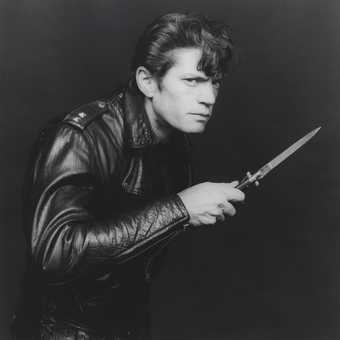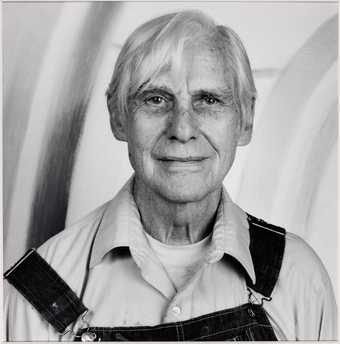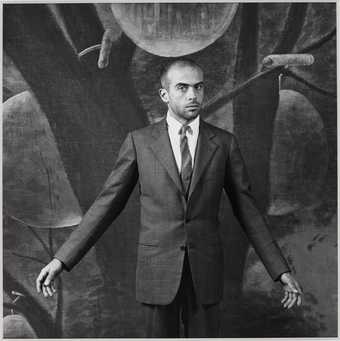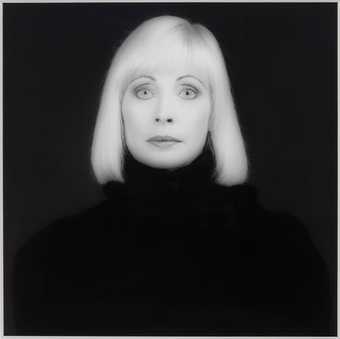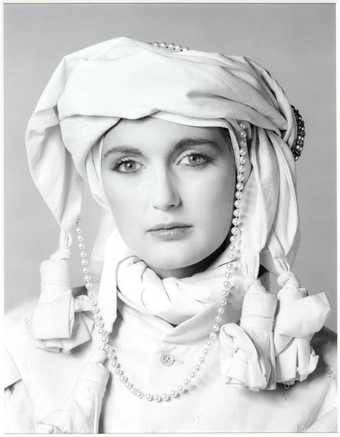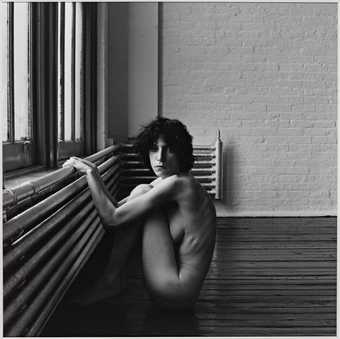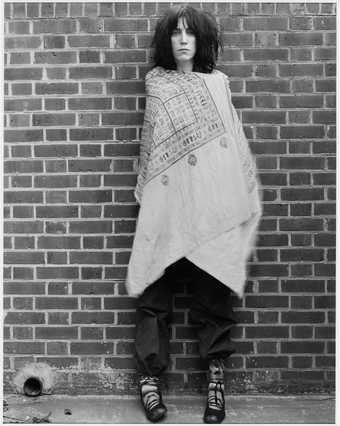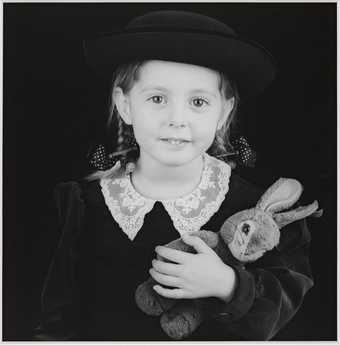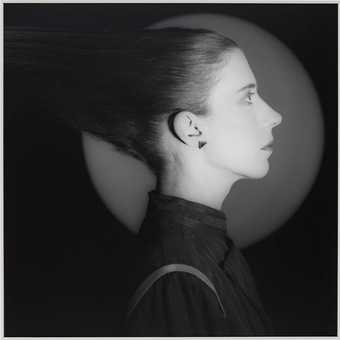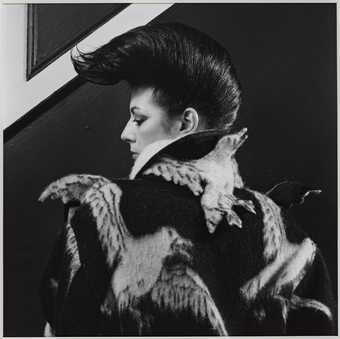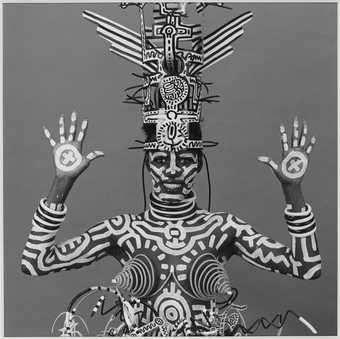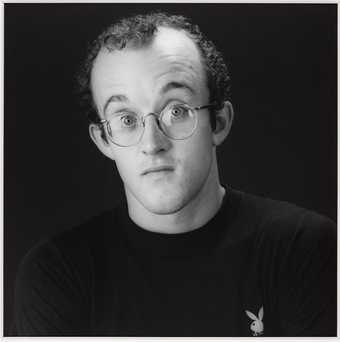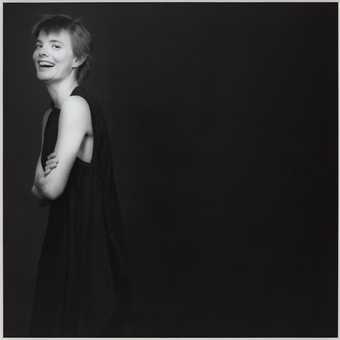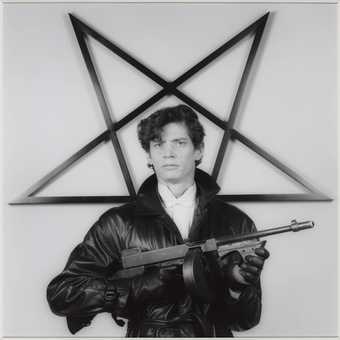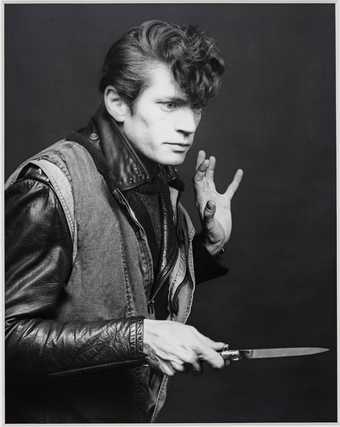
On loan
Grundy Art Gallery (Blackpool, UK): Louise Bourgeois
- Artist
- Robert Mapplethorpe 1946–1989
- Medium
- Photograph, gelatin silver print on paper
- Dimensions
- Support: 375 × 374 mm
frame: 645 × 620 × 38 mm - Collection
- ARTIST ROOMS Tate and National Galleries of Scotland
- Acquisition
- ARTIST ROOMS Acquired jointly with the National Galleries of Scotland through The d'Offay Donation with assistance from the National Heritage Memorial Fund and the Art Fund 2008
- Reference
- AR00215
Summary
In this black and white portrait photograph the French-American artist Louise Bourgeois (1911–2010) stands slightly to the right of the frame against a plain grey background. She is shown from her waist up with her body in three quarter profile, and her face turned towards the camera. She wears a dark, tufted monkey fur coat and has one of her sculptures tucked under her right arm, holding it in place with her right hand. This phallic shaped sculpture, Fillette, which translates as ‘little girl’ in French, is a plaster work covered in latex made fourteen years earlier. Bourgeois smiles somewhat mischievously at the camera.
This photograph was taken by Mapplethorpe at his studio on Bond Street, New York, in 1982. His biographer Patricia Morrisroe notes that he was not an intrusive photographer and if his sitters used props it was normally their own decision or idea, which was the case with this image. Bourgeois was convinced that the shoot was going to be a disaster, so she prepared for it: ‘I could not imagine what would go wrong but I knew that everything would go wrong if I was not prepared. So even though I travel light, I did take a piece of mine.’ (Cited in Arena: Robert Mapplethorpe, 18 March 1988.) She chose to take Fillette as she knew that she would get ‘comfort from holding and rocking the piece’ (cited in Nixon 2005, p.80). Mapplethorpe described this shoot and Bourgeois herself as surreal: ‘you couldn’t, sort of tell her too much, she was just there.’ (Cited in Arena: Robert Mapplethorpe, 18 March 1988.)
Louise Bourgeois worked as an artist from the 1930s until her death in 2010. Like Robert Mapplethorpe, Bourgeois often made art that was sexually explicit. She identified the connection between Mapplethorpe and herself: ‘I thought that it was a good collaboration because he is famous, not for his flower pictures, he is famous for his objectionable, sexual representation ... he is famous as a controversial artist and this photograph fitted in his album.’ (Cited in Arena: Robert Mapplethorpe, 18 March 1988.)
The intention of this shoot with Mapplethorpe was to produce a portrait for the catalogue of Bourgeois’s retrospective exhibition at the Museum of Modern Art, New York, in 1982. The museum used the portrait for the catalogue’s cover, but cropped it to a head shot, eliminating Fillette. This selective cropping stripped the image of its erotic humour and as the artist herself stated: ‘The glint in the eye refers to the thing I’m carrying. But they cut it. They cut it because the museum was so prudish.’ (Cited in Nixon 2005, p.73.) Art historian Mignon Nixon notes how Mapplethorpe’s photographic style enhances the image, through the ‘pristine limpidity’ of the print and by ‘delicately picking out the rhyme of flesh within the frame of an image bristling with transgressive humour’ (Nixon 2005, p.73).
Further reading
Arena: Robert Mapplethorpe, dir. by Nigel Finch, BBC television documentary, 18 March 1988.
Patricia Morrisroe, Mapplethorpe. A Biography, London 1995.
Mignon Nixon, Fantastic Reality: Louise Bourgeois and a Story of Modern Art, Cambridge, Massachusetts 2005, pp.71–81.
Susan Mc Ateer
The University of Edinburgh
February 2013
The University of Edinburgh is a research partner of ARTIST ROOMS.
Does this text contain inaccurate information or language that you feel we should improve or change? We would like to hear from you.
Online caption
Louise Bourgeois is a French-born, American artist, who began making surrealist-inspired paintings and prints, but turned to sculpture in the late 1940s. Her sculptures, often but not always abstract, have strong allusions to the human body and especially to human sexuality. In this photograph she is carrying one of her own works, a phallic-shaped sculpture that her right hand is holding in a suggestive manner. Her smile is very knowing.
Explore
- objects(23,571)
-
- clothing and personal items(5,879)
-
- coat(310)
- fine art and design, named works(6,153)
- actions: expressive(2,622)
-
- smiling(291)
- carrying / holding(866)
- woman(9,110)
- individuals: female(1,698)
- arts and entertainment(7,210)
-
- artist, sculptor(1,668)
You might like
-
Robert Mapplethorpe Self Portrait
1983, printed 2005 -
Robert Mapplethorpe Willem de Kooning
1986 -
Robert Mapplethorpe Francesco Clemente
1985 -
Robert Mapplethorpe Doris Saatchi
1983 -
Robert Mapplethorpe Francesca Thyssen
1981 -
Robert Mapplethorpe Patti Smith
1976 -
Robert Mapplethorpe Patti Smith
1976, printed 2005 -
Robert Mapplethorpe Eva Amurri
1988 -
Robert Mapplethorpe Meredith Monk
1985 -
Robert Mapplethorpe Diane Benson
1980 -
Robert Mapplethorpe Grace Jones
1984 -
Robert Mapplethorpe Keith Haring
1984 -
Robert Mapplethorpe Molissa Fenley
1983 -
Robert Mapplethorpe Self Portrait
1983 -
Robert Mapplethorpe Self Portrait
1983

